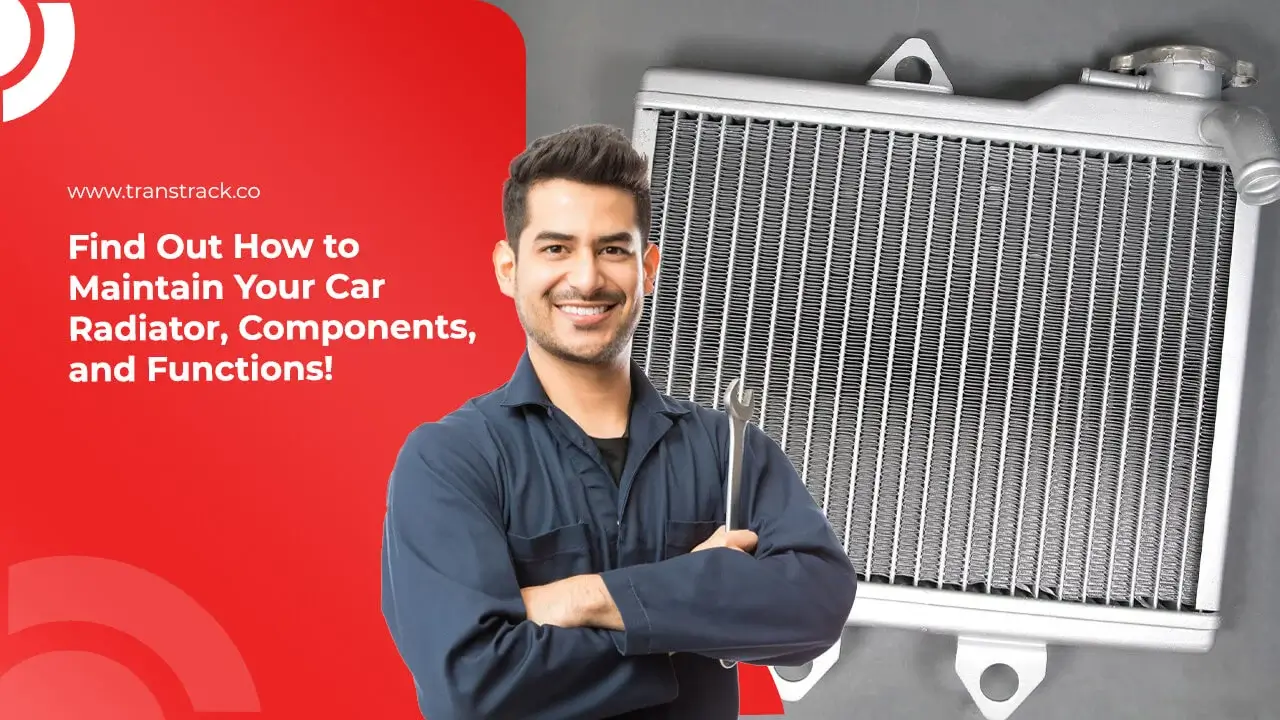Find Out How to Maintain Your Car Radiator, Components, and Functions!
Posted on February 1, 2024 by Nur Wachda Mihmidati

How to maintain car radiator? Did you know that a car radiator is one of the most vital components that keep your vehicle’s engine operating in optimal condition? Despite its small size, the radiator’s role in keeping the engine temperature stable is huge. Unfortunately, radiators are often overlooked in vehicle maintenance routines. In this article TransTRACK, we will explain the importance of regularly maintaining your car’s radiator and provide practical tips to keep your radiator healthy.
A properly functioning radiator is key to preventing overheating issues that can damage your vehicle’s engine. With proper maintenance, you can extend the life of your car’s engine and avoid costly repairs in the future. Let’s explore the simple steps you can take to keep your car radiator in tip-top shape.
Car Radiator Components
The car radiator is an important part of the vehicle cooling system that functions to cool the coolant flowing through the engine. The main components of a car radiator include:
Radiator Core
This is the main part of the radiator that consists of a series of small pipes or channels that carry coolant from the engine. The radiator core also has cooling fins that help in the heat transfer process.
Tanks
The radiator has two tanks, one at the top and one at the bottom. The upper tank usually serves as the inlet for hot coolant from the engine, while the lower tank is the outlet for cooled coolant.
Baffle or Deflector
This component serves to direct airflow into the radiator, ensuring optimal cooling. Baffles also help prevent unwanted air turbulence around the radiator.
Fan
Some cars are equipped with a radiator fan to increase airflow through the radiator when the car is stopped or running at low speeds. These fans are usually controlled by temperature via temperature sensors on the radiator or engine.
Coolant
Cooling fluid, usually a mixture of water and coolant (antifreeze chemicals), flows through the radiator to absorb heat from the engine and carry it to the radiator to be cooled again.
Thermostat
The thermostat is a temperature control valve located in the coolant path between the engine and radiator. Its function is to ensure the engine temperature remains within an optimal range by regulating the flow of coolant.
Pressure Cap
The radiator cap is an important component that helps maintain proper pressure in the cooling system. The pressure regulated by the radiator cap helps increase the boiling point of the coolant and prevents excessive evaporation.
These are some of the main components of a car radiator and its cooling system. Keep in mind that car radiators and cooling systems also consist of various sleeves, clips, clamps, and other small components that are also critical to the overall performance of the system.
Car Radiator Functions
The car radiator has several main functions in the vehicle’s cooling system, which are very important to keep the engine temperature stable and prevent damage due to overheating. Here are some of the main functions of a car radiator:
Cooling the Engine
The main function of the radiator is to cool the vehicle engine. When the engine is operating, the temperature inside rises due to the fuel combustion process. The radiator uses coolant (usually a mixture of water and coolant) to absorb heat from the engine and carry it to the radiator, where it is then transferred to the air through the cooling fins and the airflow through them.
Regulates Engine Temperature
The radiator also helps in regulating the engine temperature to keep it within the optimal range for good performance and longer engine life. When the engine temperature rises above a safe threshold, the thermostat on the cooling system will open to allow the flow of coolant to the radiator, thus cooling the engine.
Prevents Overheating
The radiator prevents the engine from overheating. Overheating can cause serious damage to the engine, such as cracking of the cylinder head or damage to other components. The radiator works to keep the engine temperature within a safe range, even in heavy operating conditions or hot weather.
Removing Excess Heat
In addition to cooling the engine, the radiator also serves to remove excess heat from the overall cooling system. This helps to maintain a balanced temperature throughout the engine and cooling system, thus preventing damage to other heat-sensitive components.
Improves Fuel Efficiency
By keeping the engine temperature within an optimal range, the radiator helps improve the fuel efficiency of the vehicle. Engines that operate at too high a temperature tend to experience inefficient combustion, which can reduce fuel efficiency and overall vehicle performance.
As such, the car radiator is a crucial component in a vehicle’s cooling system that plays an important role in maintaining engine performance, preventing overheating, and ensuring the vehicle operates properly under various conditions.
Types of Car Radiators
There are several types of car radiators that are commonly used, depending on the design and application of the vehicle. Here are some commonly encountered types of car radiators:
Straight Flow Radiator (Downflow Radiator)
This type of radiator is the most common and is often used in passenger vehicles and light trucks. In a straight-flow radiator, coolant flows vertically from top to bottom through the radiator core, with air flowing across the radiator core horizontally.
Crossflow Radiator
Crossflow radiators have a design where coolant flows horizontally across the radiator core, while air flows vertically. These radiators are often used in cars with more limited engine space or in high-performance vehicles.
Dual Core Radiator
Dual core radiators have two radiator cores that run parallel, providing more surface area for heat exchange. These radiators are often used in vehicles with high cooling requirements, such as race cars or high-performance cars.
Aluminum Radiator
Aluminum radiators use aluminum as the core material of the radiator, which has better heat conductivity compared to traditional radiators made of copper or steel alloys. Aluminum radiators are usually lighter and more efficient at transferring heat, so they are often used in high-performance cars.
Electric Radiator
Electric radiators use an electrically operated fan to increase airflow through the radiator core. These radiators are often used in cars with additional cooling requirements, such as in modified engines or in high-performance vehicles.
High Performance Radiator
High performance radiators are designed to provide more efficient cooling than standard radiators. They typically have a larger radiator core, larger tubes, and use materials such as aluminum to improve cooling performance.
Each type of radiator has its own advantages and disadvantages, and the selection of the right type of radiator will depend on the vehicle’s needs, available space, and user preferences.
How to Maintain a Car Radiator
How to maintain car radiator regularly is an important step to ensure optimal cooling system performance and prevent overheating problems that can damage the vehicle’s engine. Here are some important steps in maintaining a car radiator:
How to Maintain Car Radiator: 1. Check the Coolant
Ensure that the coolant level is at the correct level by checking the expansion tank or coolant drain tank. If necessary, add coolant with a mixture that matches the vehicle manufacturer’s specifications.
How to Maintain Car Radiator: 2. Check for Leaks
Check the radiator and hoses to ensure there are no leaks. Leaks can cause enough coolant loss to cause overheating. If a leak occurs, repair or replace the damaged component immediately.
How to Maintain Car Radiator: 3. Clean the Radiator
Clean the radiator of dirt, dust, and debris that can block airflow. You can use low-pressure air or a soft brush to clean the radiator fins. Make sure not to touch the radiator fins too roughly, as they can be easily damaged.
How to Maintain Car Radiator: 4. Check the Radiator Fan
If the vehicle is equipped with a radiator fan, make sure the fan is functioning properly. Check the fan’s wiring, switches, and relays to ensure there are no issues causing the fan to not operate properly.
How to Maintain Car Radiator: 5. Check the Thermostat
Check the thermostat to ensure it is functioning properly. A faulty thermostat can cause the engine to overheat or not reach the optimal operating temperature. If necessary, replace the thermostat according to the recommended maintenance schedule.
How to Maintain Car Radiator: 6. Wash the Cooling System
Regularly flush or wash the cooling system to remove deposits and scale that may have formed inside the radiator and engine block. This will help maintain optimal coolant flow and cooling performance.
How to Maintain Car Radiator: 7. Routine Maintenance
In addition to the steps above, perform regular maintenance according to the maintenance schedule recommended by the vehicle manufacturer. This may include coolant replacement, periodic inspection, and other maintenance as needed.
By performing regular maintenance on your car’s radiator, you can ensure optimal cooling system performance and prevent overheating issues that can damage your vehicle’s engine. If you’re unsure about how to properly maintain your radiator, it’s best to consult a trusted mechanic or repair shop.
When it comes to maintaining a healthy car radiator and cooling system efficiently, technology plays an increasingly important role. To facilitate regular maintenance and monitoring, TransTRACK has come up with an innovative solution: Vehichle Maintenance System.
Vehichle Maintenance System is a smart platform specifically designed to assist vehicle owners in managing maintenance schedules, vehicle condition monitoring, and maintenance-related updates. With the integrated system, you can easily track the last time the radiator was checked, monitor coolant levels, and receive alerts in case of potential problems.
By using TransTRACK’s Vehicle Maintenance System, you no longer have to worry about forgotten maintenance schedules or unexpected cooling issues. Be part of an era of more efficient and smarter vehicle maintenance by joining us. Get full control over the health of your car’s radiator and cooling system. Make the switch to TransTRACK’s Vehichle Maintenance System today!
Recent Post
Negative Impact of Arrogant Driver Behavior on Traffic Safety
October 31, 2024Effective Tips to Overcome Windshield Condensation for Safe Driving
October 31, 2024Topic :
vehicle enginevehicle maintenance
 Bahasa Indonesia
Bahasa Indonesia









